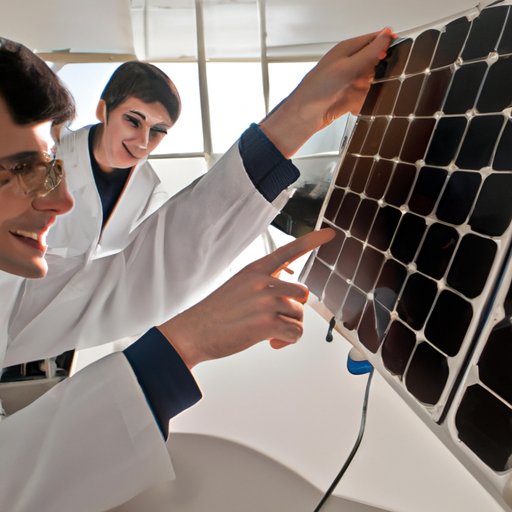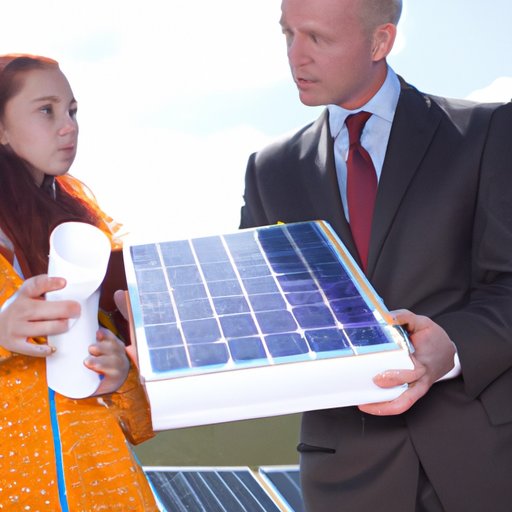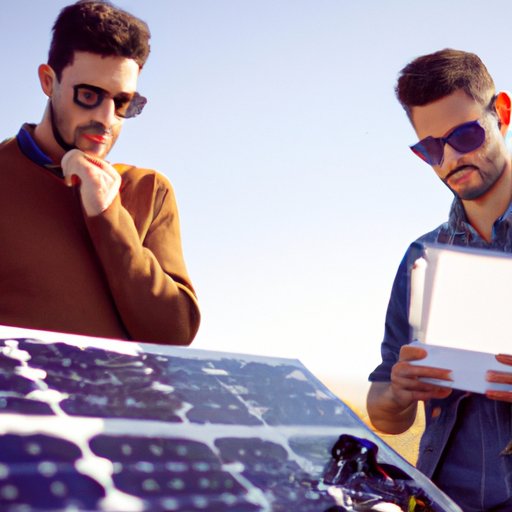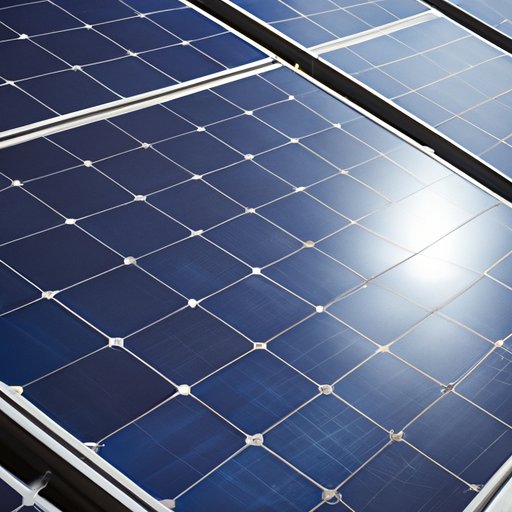Introduction
Photovoltaic (PV) cells are devices that convert sunlight into usable electricity. They are made up of semiconductor materials such as silicon, gallium arsenide, and cadmium telluride, which absorb photons from the sun’s rays and convert them into electrical energy. This article will explore the physics and chemistry behind PV cells, and how they work to generate electricity.

Exploring the Physics and Chemistry of Photovoltaic Cells
The basic structure of a PV cell consists of two layers: an upper layer of positively charged particles, called the emitter, and a lower layer of negatively charged particles, called the base. When the sun’s photons strike the cell, some of their energy is absorbed by the semiconductor material, creating an electric current. This current is then used to power electrical devices.
The photovoltaic effect is the process by which solar energy is converted into electrical energy. This effect occurs when the photons in the sun’s rays collide with the atoms in the semiconductor material, causing them to become excited and release electrons. These electrons then move through the material and create an electric current.
There are three types of PV cells: monocrystalline, polycrystalline, and amorphous. Monocrystalline cells are made from single crystal silicon and have a high efficiency rate. Polycrystalline cells are made from multiple crystals of silicon and have a slightly lower efficiency rate than monocrystalline cells. Amorphous cells are made from thin films of silicon and have the lowest efficiency rate.
Understanding the Working Principles of a Photovoltaic Cell
To understand how a PV cell works, it is important to first understand how solar energy is converted into electricity. When the sun’s photons strike the cell, they excite the electrons in the semiconductor material and cause them to move. This movement creates an electric field within the cell, which is then harnessed to generate electricity.
The role of electrons in this process is essential. Electrons are negatively charged particles, and when they move within the semiconductor material, they create a negative charge. This negative charge attracts positively charged particles, called holes, which are created when electrons leave the material. The attraction between the electrons and holes creates an electric current, which is then used to generate electricity.
Analyzing the Components of a Photovoltaic Cell
A PV cell consists of several different components, each of which plays an important role in the generation of electricity. The most important component is the semiconductor material, which absorbs the energy from the sun’s photons and converts it into electricity. Other components include the electrodes, which collect the electric current generated by the cell, and the contacts, which connect the electrodes to the outside world.
Each component of a PV cell works together to generate electricity. The semiconductor material absorbs the energy from the sun’s photons, while the electrodes collect the electric current. The contacts then transmit the electricity to the outside world, where it can be used to power electrical devices.

Examining How Solar Energy is Converted into Electricity
The conversion of solar energy into electricity involves two processes: the creation of electron-hole pairs and the flow of electric current. When photons strike the semiconductor material, they excite the electrons and cause them to move. This movement creates an electric field within the cell, which is then used to generate electricity.
The second process involves the creation of electron-hole pairs. When electrons move within the material, they create a negative charge. This negative charge attracts positively charged particles, called holes, which are created when electrons leave the material. The attraction between the electrons and holes creates an electric current, which is then used to generate electricity.

Investigating the Benefits of Photovoltaic Cells
Photovoltaic cells offer many benefits, both environmental and economic. They are a clean and renewable source of energy, meaning they do not produce any pollutants or emissions. In addition, they require little maintenance and can last for decades. Furthermore, they can be used to generate electricity in remote areas where access to traditional energy sources is limited.
In terms of economics, PV cells can be more cost-effective than traditional energy sources. They require no fuel and have low operating costs. Furthermore, they can be used to generate electricity during peak periods when traditional sources may be more expensive.
Designing and Manufacturing Photovoltaic Cells
Designing and manufacturing PV cells requires careful consideration of several factors. The type of semiconductor material used must be chosen based on its ability to absorb the sun’s energy and convert it into electricity. The size and shape of the cells must also be taken into account, as well as the number of cells needed to generate a given amount of electricity.
Manufacturing PV cells requires specialized equipment, including deposition systems, laser systems, and etching systems. These systems are used to deposit, cut, and etch the semiconductor material into the desired shape and size. Once the cells have been manufactured, they are tested for efficiency and reliability before being sold to consumers.
Evaluating the Cost-Effectiveness of Photovoltaic Cells
The cost of PV cells depends on several factors, including the type of semiconductor material used, the size and shape of the cells, and the number of cells needed to generate a given amount of electricity. Generally speaking, the larger the system, the more expensive it will be. However, when compared to traditional energy sources, PV cells can often be more cost-effective.
When comparing the cost-effectiveness of PV cells to other energy sources, it is important to consider the long-term savings. PV cells require little maintenance and can last for decades, whereas traditional sources may require frequent repairs and replacements. Additionally, PV cells generate electricity without producing any pollutants or emissions, making them a more environmentally friendly option.
Conclusion
This article explored the physics and chemistry behind PV cells, and how they work to generate electricity. It examined the components of a PV cell and the electron-hole pair creation process, as well as the environmental and economic advantages of these cells. Additionally, it evaluated the cost-effectiveness of photovoltaic cells compared to other energy sources.
It is clear that PV cells offer many benefits, both environmental and economic. As technology continues to advance, these cells are becoming increasingly efficient and cost-effective. For those looking for a clean and renewable energy source, PV cells may be the perfect solution.
(Note: Is this article not meeting your expectations? Do you have knowledge or insights to share? Unlock new opportunities and expand your reach by joining our authors team. Click Registration to join us and share your expertise with our readers.)
